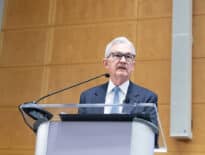
Developers of the 350,000-square-foot Forum lab project at Boston Landing in Brighton are seeking to attract smaller life science tenants to spur leasing activity. Image courtesy of SGA
In a direct contrast to the office market, where tenants have gravitated to new high-end buildings for lease commitments since 2020, life science developers are finding muted demand for the new crop of lab buildings dotting the local landscape.
Nearly a third of the space in 2023 developments is still available, according to Colliers research, amid a wide imbalance between new supply and tenant demand. Lab buildings and conversion projects completed in 2022 and 2023 account for 40 percent of all vacancies in Greater Boston.
In a first for the local market, more than 5 million square feet of life science space is available, a 16-fold increase from the historically tight 2021 market.
“Given the combination of muted demand and millions of square feet of yet-to-be-leased space under construction across the metro, vacancies are likely to rise further,” researchers Jeffrey Myers and Kelly Doonan wrote.
The 2.2 million square feet of uncommitted space in 2022-2023 completions exceeds total tenant requirements in the market, currently 2 million square feet. Tenant requirements peaked at 8 million square feet in 2021. But investors’ more conservative funding patterns in the past year have prompted many companies to place expansion plans on hold or list sublease space.
Lab developers have shifted leasing strategies in an attempt to spur leasing momentum, offering to break up floor plates for multiple tenants and increasing space dedicated for incubators that rent space to startups on a short-term basis.
The 11.7 percent vacancy rate across the 46 million-square-foot Greater Boston lab market represents a decade-long high and will likely rise further, Colliers predicts. The 2.1 million square feet of sublease listings is twice the historical norm.
Not even the industry hub of Cambridge has been immune to the downsizing by life science firms, with over 740,000 square feet of sublease space available in the 13.5 million-square-foot East Cambridge submarket. East Cambridge’s vacancy rate now stands at 8.8 percent.
The inner suburbs, spanning nearly 4 million square feet of lab space, now has a 32.4 percent vacancy rate including more than 1 million square feet of space available for direct lease.








